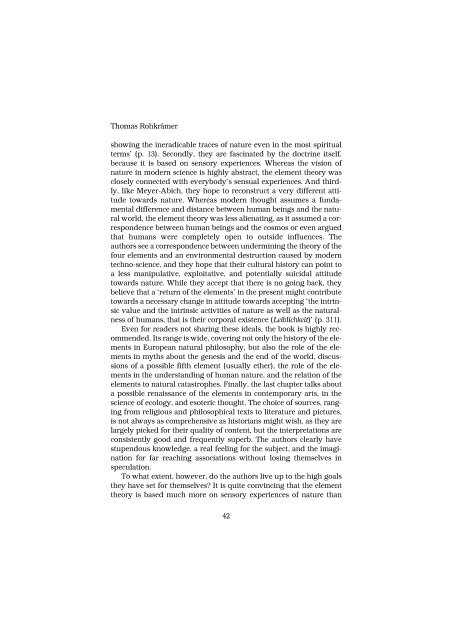Download - German Historical Institute London
Download - German Historical Institute London
Download - German Historical Institute London
You also want an ePaper? Increase the reach of your titles
YUMPU automatically turns print PDFs into web optimized ePapers that Google loves.
Thomas Rohkrämer<br />
showing the ineradicable traces of nature even in the most spiritual<br />
terms’ (p. 13). Secondly, they are fascinated by the doctrine itself,<br />
because it is based on sensory experiences. Whereas the vision of<br />
nature in modern science is highly abstract, the element theory was<br />
closely connected with everybody’s sensual experiences. And thirdly,<br />
like Meyer-Abich, they hope to reconstruct a very different attitude<br />
towards nature. Whereas modern thought assumes a fundamental<br />
difference and distance between human beings and the natural<br />
world, the element theory was less alienating, as it assumed a correspondence<br />
between human beings and the cosmos or even argued<br />
that humans were completely open to outside influences. The<br />
authors see a correspondence between undermining the theory of the<br />
four elements and an environmental destruction caused by modern<br />
techno-science, and they hope that their cultural history can point to<br />
a less manipulative, exploitative, and potentially suicidal attitude<br />
towards nature. While they accept that there is no going back, they<br />
believe that a ‘return of the elements’ in the present might contribute<br />
towards a necessary change in attitude towards accepting ‘the intrinsic<br />
value and the intrinsic activities of nature as well as the naturalness<br />
of humans, that is their corporal existence (Leiblichkeit)’ (p. 311).<br />
Even for readers not sharing these ideals, the book is highly recommended.<br />
Its range is wide, covering not only the history of the elements<br />
in European natural philosophy, but also the role of the elements<br />
in myths about the genesis and the end of the world, discussions<br />
of a possible fifth element (usually ether), the role of the elements<br />
in the understanding of human nature, and the relation of the<br />
elements to natural catastrophes. Finally, the last chapter talks about<br />
a possible renaissance of the elements in contemporary arts, in the<br />
science of ecology, and esoteric thought. The choice of sources, ranging<br />
from religious and philosophical texts to literature and pictures,<br />
is not always as comprehensive as historians might wish, as they are<br />
largely picked for their quality of content, but the interpretations are<br />
consistently good and frequently superb. The authors clearly have<br />
stupendous knowledge, a real feeling for the subject, and the imagination<br />
for far reaching associations without losing themselves in<br />
speculation.<br />
To what extent, however, do the authors live up to the high goals<br />
they have set for themselves? It is quite convincing that the element<br />
theory is based much more on sensory experiences of nature than<br />
42













